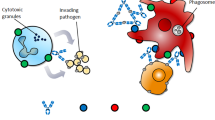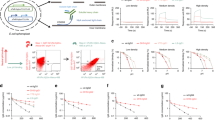Abstract
We have engineered the Fc region of a human immunoglobulin G (IgG) to generate a mutated antibody that modulates the concentrations of endogenous IgGs in vivo. This has been achieved by targeting the activity of the Fc receptor, FcRn, which serves through its IgG salvage function to maintain and regulate IgG concentrations in the body. We show that an IgG whose Fc region was engineered to bind with higher affinity and reduced pH dependence to FcRn potently inhibits FcRn-IgG interactions and induces a rapid decrease of IgG levels in mice. Such FcRn blockers (or 'Abdegs,' for antibodies that enhance IgG degradation) may have uses in reducing IgG levels in antibody-mediated diseases and in inducing the rapid clearance of IgG-toxin or IgG-drug complexes.
This is a preview of subscription content, access via your institution
Access options
Subscribe to this journal
Receive 12 print issues and online access
$209.00 per year
only $17.42 per issue
Buy this article
- Purchase on Springer Link
- Instant access to full article PDF
Prices may be subject to local taxes which are calculated during checkout





Similar content being viewed by others
References
Souriau, C. & Hudson, P.J. Recombinant antibodies for cancer diagnosis and therapy. Expert Opin. Biol. Ther. 3, 305–318 (2003).
Weiner, L.M. & Carter, P. Tunable antibodies. Nat. Biotechnol. 23, 556–557 (2005).
Lewis, E.J. & Schwartz, M.M. Pathology of lupus nephritis. Lupus 14, 31–38 (2005).
Dickinson, B.L. et al. Bidirectional FcRn-dependent IgG transport in a polarized human intestinal epithelial cell line. J. Clin. Invest. 104, 903–911 (1999).
McCarthy, K.M., Yoong, Y. & Simister, N.E. Bidirectional transcytosis of IgG by the rat neonatal Fc receptor expressed in a rat kidney cell line: a system to study protein transport across epithelia. J. Cell Sci. 113, 1277–1285 (2000).
Antohe, F., Radulescu, L., Gafencu, A., Ghetie, V. & Simionescu, M. Expression of functionally active FcRn and the differentiated bidirectional transport of IgG in human placental endothelial cells. Hum. Immunol. 62, 93–105 (2001).
Kobayashi, N. et al. FcRn-mediated transcytosis of immunoglobulin G in human renal proximal tubular epithelial cells. Am. J. Physiol. Renal Physiol. 282, F358–F365 (2002).
Spiekermann, G.M. et al. Receptor-mediated immunoglobulin G transport across mucosal barriers in adult life: functional expression of FcRn in the mammalian lung. J. Exp. Med. 196, 303–310 (2002).
Claypool, S.M. et al. Bidirectional transepithelial IgG transport by a strongly polarized basolateral membrane Fc-γ receptor. Mol. Biol. Cell 15, 1746–1759 (2004).
Ober, R.J., Martinez, C., Vaccaro, C., Zhou, J. & Ward, E.S. Visualizing the site and dynamics of IgG salvage by the MHC class I-related receptor, FcRn. J. Immunol. 172, 2021–2029 (2004).
Ober, R.J., Martinez, C., Lai, X., Zhou, J. & Ward, E.S. Exocytosis of IgG as mediated by the receptor, FcRn: an analysis at the single-molecule level. Proc. Natl. Acad. Sci. USA 101, 11076–11081 (2004).
Rodewald, R. & Kraehenbuhl, J.P. Receptor-mediated transport of IgG. J. Cell Biol. 99, 159s–164s (1984).
Simister, N.E. & Rees, A.R. Isolation and characterization of an Fc receptor from neonatal rat small intestine. Eur. J. Immunol. 15, 733–738 (1985).
Ghetie, V. et al. Abnormally short serum half-lives of IgG in beta 2-microglobulin-deficient mice. Eur. J. Immunol. 26, 690–696 (1996).
Junghans, R.P. & Anderson, C.L. The protection receptor for IgG catabolism is the beta2-microglobulin- containing neonatal intestinal transport receptor. Proc. Natl. Acad. Sci. USA 93, 5512–5516 (1996).
Israel, E.J., Wilsker, D.F., Hayes, K.C., Schoenfeld, D. & Simister, N.E. Increased clearance of IgG in mice that lack beta 2-microglobulin: possible protective role of FcRn. Immunology 89, 573–578 (1996).
Raghavan, M., Bonagura, V.R., Morrison, S.L. & Bjorkman, P.J. Analysis of the pH dependence of the neonatal Fc receptor/immunoglobulin G interaction using antibody and receptor variants. Biochemistry 34, 14649–14657 (1995).
Popov, S. et al. The stoichiometry and affinity of the interaction of murine Fc fragments with the MHC class I-related receptor, FcRn. Mol. Immunol. 33, 521–530 (1996).
Medesan, C., Matesoi, D., Radu, C., Ghetie, V. & Ward, E.S. Delineation of the amino acid residues involved in transcytosis and catabolism of mouse IgG1. J. Immunol. 158, 2211–2217 (1997).
Kim, J.K. et al. Mapping the site on human IgG for binding of the MHC class I-related receptor, FcRn. Eur. J. Immunol. 29, 2819–2825 (1999).
Martin, W.L., West, A.P.J., Gan, L. & Bjorkman, P.J. Crystal structure at 2.8 Å of an FcRn/heterodimeric Fc complex: mechanism of pH dependent binding. Mol. Cell 7, 867–877 (2001).
Shields, R.L. et al. High resolution mapping of the binding site on human IgG1 for Fc gamma RI, Fc gamma RII, Fc gamma RIII, and FcRn and design of IgG1 variants with improved binding to the Fc gamma R. J. Biol. Chem. 276, 6591–6604 (2001).
Kabat, E.A., Wu, T.T., Perry, H.M., Gottesman, K.S. & Foeller, C. (eds.) Sequences of Proteins of Immunological Interest (US Dept. of Health and Human Services, Bethesda, MD, 1991).
Ghetie, V. et al. Increasing the serum persistence of an IgG fragment by random mutagenesis. Nat. Biotechnol. 15, 637–640 (1997).
Hinton, P.R. et al. Engineered human IgG antibodies with longer serum half-lives in primates. J. Biol. Chem. 279, 6213–6216 (2004).
Dall'Acqua, W. et al. Increasing the affinity of a human IgG1 to the neonatal Fc receptor: biological consequences. J. Immunol. 169, 5171–5180 (2002).
Zhou, J., Johnson, J.E., Ghetie, V., Ober, R.J. & Ward, E.S. Generation of mutated variants of the human form of the MHC class I-related receptor, FcRn, with increased affinity for mouse immunoglobulin G. J. Mol. Biol. 332, 901–913 (2003).
Yoshida, M. et al. Human neonatal Fc receptor mediates transport of IgG into luminal secretions for delivery of antigens to mucosal dendritic cells. Immunity 20, 769–783 (2004).
Berryman, M. & Rodewald, R. Beta 2-microglobulin co-distributes with the heavy chain of the intestinal IgG-Fc receptor throughout the transepithelial transport pathway of the neonatal rat. J. Cell Sci. 108, 2347–2360 (1995).
Semple, J.W. Immune pathophysiology of autoimmune thrombocytopenic purpura. Blood Rev. 16, 9–12 (2002).
Israel, E.J., Patel, V.K., Taylor, S.F., Marshak-Rothstein, A. & Simister, N.E. Requirement for a beta 2-microglobulin-associated Fc receptor for acquisition of maternal IgG by fetal and neonatal mice. J. Immunol. 154, 6246–6251 (1995).
Firan, M. et al. The MHC class I related receptor, FcRn, plays an essential role in the maternofetal transfer of gammaglobulin in humans. Int. Immunol. 13, 993–1002 (2001).
Takai, T. Fc receptors and their role in immune regulation and autoimmunity. J. Clin. Immunol. 25, 1–18 (2005).
Bleeker, W.K., Teeling, J.L. & Hack, C.E. Accelerated autoantibody clearance by intravenous immunoglobulin therapy: studies in experimental models to determine the magnitude and time course of the effect. Blood 98, 3136–3142 (2001).
Samuelsson, A., Towers, T.L. & Ravetch, J.V. Anti-inflammatory activity of IVIG mediated through the inhibitory Fc receptor. Science 291, 484–486 (2001).
Mouthon, L. et al. Mechanisms of action of intravenous immune globulin in immune-mediated diseases. Clin. Exp. Immunol. (suppl. 1) 104, 3–9 (1996).
Yu, Z. & Lennon, V.A. Mechanism of intravenous immune globulin therapy in antibody-mediated autoimmune diseases. N. Engl. J. Med. 340, 227–228 (1999).
Akilesh, S. et al. The MHC class I-like Fc receptor promotes humorally mediated autoimmune disease. J. Clin. Invest. 113, 1328–1333 (2004).
Ober, R.J., Radu, C.G., Ghetie, V. & Ward, E.S. Differences in promiscuity for antibody-FcRn interactions across species: implications for therapeutic antibodies. Int. Immunol. 13, 1551–1559 (2001).
Zhou, J., Mateos, F., Ober, R.J. & Ward, E.S. Conferring the binding properties of the mouse MHC class I-related receptor, FcRn, onto the human ortholog by sequential rounds of site-directed mutagenesis. J. Mol. Biol. 345, 1071–1081 (2005).
Foote, J. & Winter, G. Antibody framework residues affecting the conformation of the hypervariable loops. J. Mol. Biol. 224, 487–499 (1992).
Horton, R.M., Hunt, H.D., Ho, S.N., Pullen, J.K. & Pease, L.R. Engineering hybrid genes without the use of restriction enzymes: gene splicing by overlap extension. Gene 77, 61–68 (1989).
O'Connell, K.A. & Edidin, M. A mouse lymphoid endothelial cell line immortalized by simian virus 40 binds lymphocytes and retains functional characteristics of normal endothelial cells. J. Immunol. 144, 521–525 (1990).
Brewer, C.B. Cytomegalovirus plasmid vectors for permanent lines of polarized epithelial cells. Methods Cell Biol. 43 Pt A, 233–245 (1994).
Kim, J.K., Tsen, M.F., Ghetie, V. & Ward, E.S. Identifying amino acid residues that influence plasma clearance of murine IgG1 fragments by site-directed mutagenesis. Eur. J. Immunol. 24, 542–548 (1994).
Amit, A.G., Mariuzza, R.A., Phillips, S.E. & Poljak, R.J. Three-dimensional structure of an antigen-antibody complex at 2.8 Å resolution. Science 233, 747–753 (1986).
Schuck, P., Radu, C.G. & Ward, E.S. Sedimentation equilibrium analysis of recombinant mouse FcRn with murine IgG1. Mol. Immunol. 36, 1117–1125 (1999).
Martin, W.L. & Bjorkman, P.J. Characterization of the 2:1 complex between the class I MHC-related Fc receptor and its Fc ligand in solution. Biochemistry 38, 12639–12647 (1999).
Deisenhofer, J. Crystallographic refinement and atomic models of a human Fc fragment and its complex with fragment B of protein A from Staphylococcus aureus at 2.9- and 2.8-Å resolution. Biochemistry 20, 2361–2370 (1981).
Acknowledgements
We are grateful to Fernando Mateos, Jerry Chao and Rafael Guevara for excellent technical assistance. We also thank Steven Gibbons and Sripad Ram for assistance with preparation of the figures. This study was supported by grants from the National Institutes of Health R01 AI 39167, RO1 AI 55556 (E.S.W.) and R01 AI 50747 (R.J.O).
Author information
Authors and Affiliations
Corresponding author
Ethics declarations
Competing interests
The University of Texas Southwestern Medical Center has filed a patent application describing the technology in this paper.
Supplementary information
Rights and permissions
About this article
Cite this article
Vaccaro, C., Zhou, J., Ober, R. et al. Engineering the Fc region of immunoglobulin G to modulate in vivo antibody levels. Nat Biotechnol 23, 1283–1288 (2005). https://doi.org/10.1038/nbt1143
Received:
Accepted:
Published:
Issue Date:
DOI: https://doi.org/10.1038/nbt1143
This article is cited by
-
The therapeutic age of the neonatal Fc receptor
Nature Reviews Immunology (2023)
-
Derivatization with fatty acids in peptide and protein drug discovery
Nature Reviews Drug Discovery (2023)
-
Human IgE does not bind to human FcRn
Scientific Reports (2022)
-
Therapeutic Monoclonal Antibody Therapies in Chronic Autoimmune Demyelinating Neuropathies
Neurotherapeutics (2022)
-
A Charge Variant of Bevacizumab Offers Enhanced FcRn-Dependent Pharmacokinetic Half-Life and Efficacy
Pharmaceutical Research (2022)



